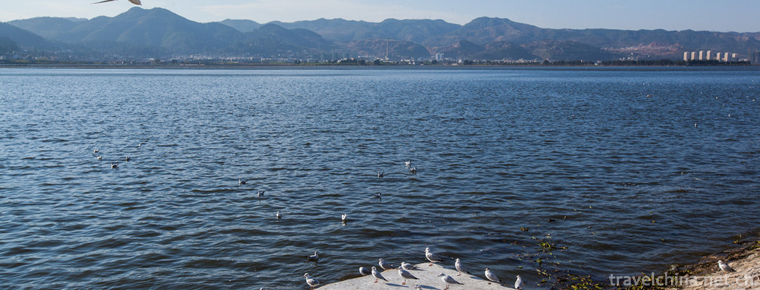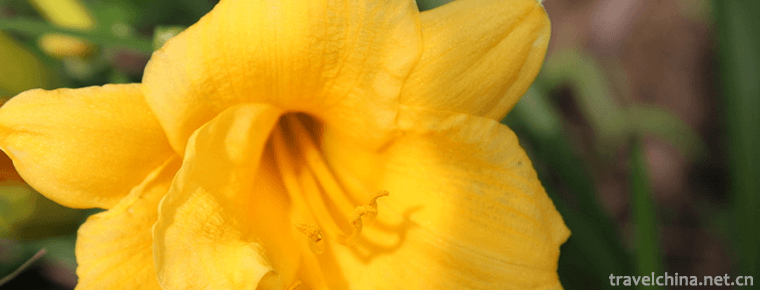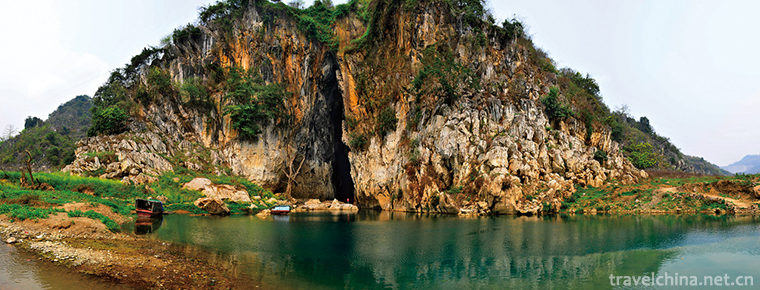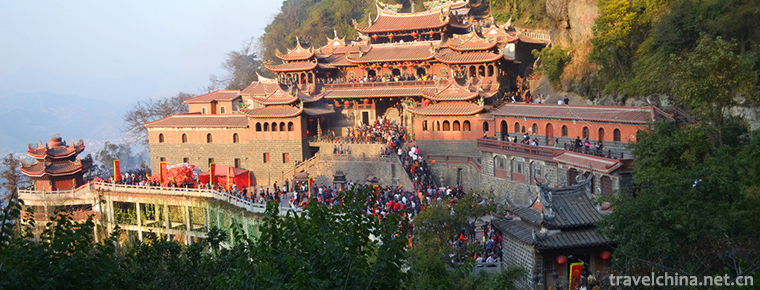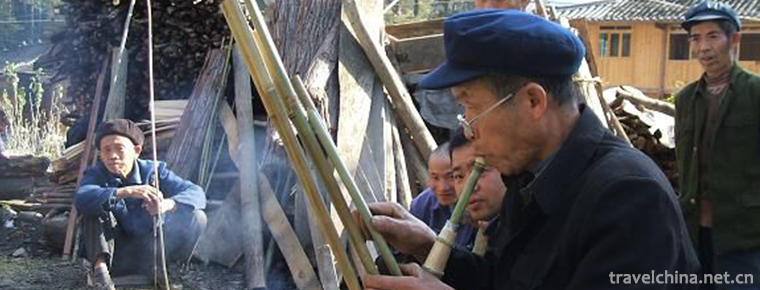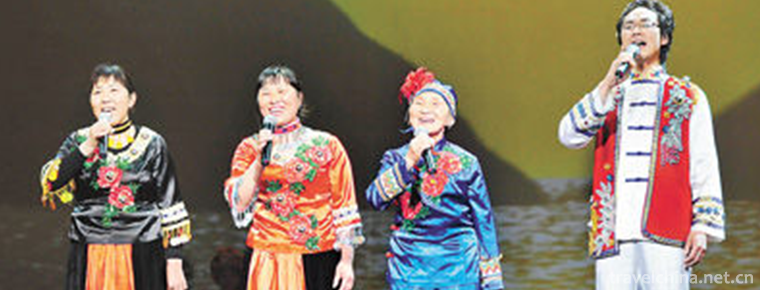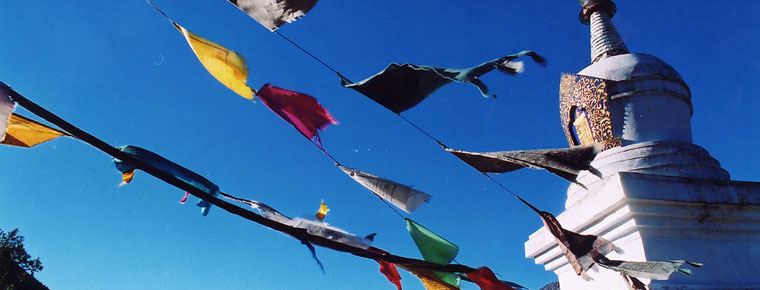Grand Buddha at Ling Shan
Lingshan Grand Buddha is a world famous scenic spot, located between the mountains and rivers of Mashan National Scenic Spot in Wuxi City, Jiangsu Province. It is also one of the important parts of Lingshan Scenic Spot in Wuxi City, a national AAAAA-level scenic spot. The Buddha body is situated on the south side of Qinlu Peak in Wuxi Ma Mountain. It opened on November 15, 1997. The location of the Great Buddha is Xiaoling Mountain named by Xuanzang of Tang Dynasty, so it is called "Lingshan Great Buddha".
Lingshan Buddha is one of the city symbols of Wuxi, which is of great significance to social culture and economic development. Nanjing artist Wu Xianlin is responsible for the sculpture design.
Construction process
Lingshan Buddha began to lay its foundation in 1994 and opened in 1997. It was built with the strong support of Mr. Zhao Puchulao, former president of Buddhist Association.
The foundry of the Buddha is a large-scale and difficult project. The Preparatory Committee has decided to build the project by Nanjing Chengguang Group. Nanjing Morning Light Group has reliable technology and has accumulated rich experience in the construction of the Hong Kong Temple of Heaven Buddha. The architectural design of the Great Buddha is undertaken by East China Architectural Design Institute, which is famous for its design of Shanghai Oriental Pearl TV Tower.
The main data of Lingshan Buddha are as follows:
1. The Lingshan Great Buddha is 88 meters tall, 79 meters tall and 9 meters tall. 2. The Lingshan Buddha body (excluding lotus petals) consists of 1 560 6-8 mm thick copper wallboards with a weld length of more than 30 km. 3. Lingshan Great Buddha casts about 725 tons of copper, covering an area of more than 9,000 square meters, about the size of a football field and a half. 4. Because of the application of high technology, Lingshan Grand Buddha can withstand the attack of typhoons with magnitude 14 and earthquakes with magnitude 8.
The creation of Lingshan Buddha is based on the records of the 32 forms of Buddhist Sutra Tathagata. Big Buddha's benevolent face smiles, widespread viewing of all living beings, right hand "Shi fearlessness seal" represents pain, left hand "Shi and wish seal" represents happiness, which is the phase of blessing. The whole Buddha statue is solemn and complete, serene and dignified and meticulous, showing Buddha's benevolent law.
cultural meaning
Buddhist Sutra has clouds: Every new Buddha statue is completed, it must be opened, and its sacred significance can only be possessed. The grand ceremony of the opening of Lingshan Buddha is co-hosted by the great monks and virtues of the three major sects in the world today. The scene was decorated with thousands of pots of flowers and kilometers of yellow silk. The 500-metre pilgrimage road is covered with Buddhist flags, 218-level Dengyun Road is covered with golden chrysanthemums, thousands of trees are covered with yellow cloth, and ten thousand pigeons fly around the Buddha. Fan Yin curls, drums and music resonate, reproducing the Buddha's life scene; the gathering of believers, burning incense and offering sacrifices, fully demonstrates the Buddha's virtue of returning to his heart. On the day of light, from 4 a.m., followers from all over the country came to Ma Shan from the urban area. The traffic stretched for more than 20 kilometers and lasted for nearly four hours. It is the day when the clouds hang low and the breeze dances slowly around the Buddha. With the magician's graceful sutras, the auspicious clouds float up and the mist disperses. The Buddha's benevolent face appears: half-curved eyebrows, like laughter without wisdom; kind eyes closed, like words first heard. Tens of thousands of believers worship devoutly, acquiesce in their wishes, joy and happiness, and show good luck. The scene of the Grand Buddha's Kaiguang is reserved as it is. The video will be circulated soon so that more visitors who fail to come to the site can enjoy the grand occasion of Kaiguang and get together with each other. Great Buddha is made of tin bronze. Besides the eternity of bronze pieces, the bronze art is derived from the essence of classical art. It is also a splendid part of the traditional culture of the Chinese nation. The bronze art is simple, elegant and meticulous, and enjoys a lofty position in the world.
Looking back on the history of China and Buddhism, in every prosperous era, there will be a highly civilized art crystallization, lasting for thousands of generations. For Buddha statues, great achievements have been made, from Yungang and Longmen to Dunhuang and Dazu. Today, there are Lingshan Buddhas, which form a pattern of five-sided five-Buddhas standing tall and echoing in the east, Wuxi Lingshan Buddha in Jiangsu, Tiantan Buddha in Hong Kong in the south, Leshan Buddha in Sichuan in the west, Yungang Buddha in Shanxi in the north, and Longmen Buddha in Luoyang, Henan.
Lingshan Buddha stands on Xiaoling Mountain near Taihu Lake in Wuxi, reflecting the economic development, cultural prosperity, social stability and peace of East China, which is also an important manifestation of China's policy of freedom of religious belief, and symbolizing peace and life as bronze, evergreen as ever. Lingshan Scenic Spot is 17 kilometers away from Wuxi City. There are special tourist highways connected with each other. It is located on the Shanghai-Nanjing Expressway and the Beijing-Shanghai artery. The traffic is very convenient. The high-speed yacht that has been opened integrates Lingshan scenic spot with old and new scenic spots such as Yuantouzhu, Three Kingdoms City, Shuihucheng and Huanghua Bay in 45 minutes, and there are cruise ships connecting with Suzhou, Huzhou and Hangzhou, thus forming a more compact tourist plate around Taihu Lake. In addition, the Buddha is facing Taihu Lake, Qinglong Mountain on the left, Baihu Mountain on the right and Lingshan Mountain on the back.
Have a long history
Lingshan area's history can be traced back to Tang Dynasty more than 1000 years ago. It is said that Xuanzang returned from the West and traveled southeast to Xiaolingshan. He came to Xiaolingshan, where he saw "mountains and lushes". The scenery was extraordinary and he was greatly appreciated. He said that "there is no difference between the victory of Lingshan vulture in Xizhu country"! So he named the mountain Xiaoling Mountain. The Lingyu Mountain in India is the place where Sakyamuni attained Buddhism. It is a famous Buddhist holy place. He asked his disciples to peep at Ji to preside over the Dharma. Xiaolingshan Temple developed gradually. Lingshan Buddha stands at the southern foot of Xiaoling Mountain. The height of Lingshan Buddha, including the lotus pedestal, is 88 meters, which is equivalent to the height of a building with more than 30 stories. It is 17 meters higher than the Sichuan Leshan Buddha, which is a mountain. It is the second tallest giant Buddha statue in China. If three layers of base are added, the total height will reach 1.05 meters. Lingshan Buddha looked down with wise and kind eyes. Whether the tourists are near or far away, they seem to be in the concern of the eyes of the great Buddha; and as people are close or far away, their eyes seem to be slightly open and close, and the closer they are, the more open they will be; their lips seem to laugh without laughing, they want to speak without saying anything, and many commands are about to be exported, which makes people feel more cordial and arouse all kinds of reverie. Close to the Buddha, looking up, the blue sky is long and white clouds, making people feel that the Buddha is "moving". The body parts of Lingshan Buddha are symmetrical and moderate, and the clothing folds are bright and smooth, elegant and agile, which increase the sense of motion and make the long-term and short-term vision very appropriate.
The creation of Lingshan Buddha is based on the records of the 32 forms of Buddhist Sutra Tathagata. Big Buddha's benevolent face smiles, widespread viewing of all living beings, right hand "Shi fearlessness seal" represents pain, left hand "and wish seal" represents happiness, which is the phase of blessing. The whole Buddha's form is solemn and complete, serene, dignified and meticulous, showing the Buddha's benevolent phases.
protect
The Buddha's body and lotus pedestal of Lingshan Buddha are all assembled and welded by tin bronze plates. The total amount of copper used is more than 700 tons. The Buddha body part (excluding lotus pedestal) consists of 1,560 copper wallboards. The average area of each copper wallboard is about 5 square meters. Some of the copper wallboards have a spreading area of more than 20 square meters, but the thickness is only about 7 millimeters. Such a tall Buddha is made up of so many copper panels. When assembling, it is not only necessary to ensure seamless clothing, smooth lines, perfect image and overall non-twisting, but also has strict requirements for wind resistance, shock resistance, lightning protection and atmospheric corrosion resistance. Its technical difficulty and engineering workload are obvious. With the cooperation of many units in China, after more than three years of efforts, Lingshan Buddha stands on the top of Xiaolingshan Mountain as scheduled, and officially opened on November 15, 1997. The pattern of the five sides and five Buddhas proposed by Mr. Zhao Puchu has been formed. The lotus pedestal under the foot of Lingshan Buddha is also made of tin bronze. The lotus pedestal consists of four layers of lotus petals, each of which has 22 petals and a total of 88 petals. Anyone who has contributed more than RMB 5 million yuan can engrave his name on one of the lotus petals.
Mr. Zhao Puchu praised Lingshan Grand Buddha with a poem: "The lake is shining with pure glaze, and it is well known to shine back on Lingshan Mountain." The body and the clouds apply the law and rain together, and the eyes show deep kindness to all. From the sacred sites in Wuxi, Sui Shun group when the situation is prosperous. Welcome to my friend, teacher and son, and to a peaceful world.
Ornamental
Because Lingshan Buddha is so tall, it is necessary to keep a certain distance when looking forward or taking pictures in order to achieve better results. In the skirt room of the Great Buddha's base, two elevators are specially set up to send messengers and tourists to the lotus seat and to touch the Buddha's feet in front of the Buddha's feet, which is called "holding Buddha's feet". At this time, people will find that their height is similar to the height of the big Buddha's thumb toe, thus further realizing the magnificence of Lingshan Buddha.
Facing the wall
Zhaobi is a traditional architectural form in China. The whole length of Dazhabi in Lingshan is 39.8 meters, and the highest height is 7.2 meters. The scale of Dazhabi in Lingshan is the largest in China. Lingshan Dazhaobi and Lingshan scenic spot have a very important relationship with the whole terrain environment. The whole terrain of Lingshan Grand Buddha Scenic Area is like a Taishi chair, backed by Xiaoling Mountain, Qinglong Mountain on the left, Baihu Mountain on the right, Qingfeng Mountain on the north, and the beauty of mountain shape. Taihu Lake on the south, and a beautiful water color. This traditional geomancy theory calls "Eight Winds Still Blowing, Sitting on Purple Golden Lotus" terrain is Daji's place to preserve this auspicious place. Auspicious spirituality, so create a big wall to absorb the spirits, but also through the content of the wall to guide tourists into the Lingshan Buddhist cultural and historical world. Zhaobi stands in the seven-color lotus pond. Lotus is one of the auspicious flowers and trees of Buddhism. It is said that Buddha would walk and walk seven steps after birth. Each step is a blooming lotus flower. This is the allusion of the seven-step lotus flower. The southern facade of Zhaobi is a large stone sculpture of Lingshan Winning Meeting, which is based on the Buddhist sutra's Western Lingjiushan saying. Buddhas and Bodhisattvas inherit the allusions of listening to the Sutras. The stone carvings are composed of Buddha, four great Bodhisattvas, two disciples and 500 Buddhist figures. On the north side of Zhaobi is "the picture of Xiaoling Mountain of Zen bestowed by Tang monks", which is a historical allusion about Lingshan. Visitors often ask about the origin of Lingshan Scenic Spot. In fact, this picture explains the reason. It is said that during the Zhenguan Period of the Tang Dynasty, Master Xuanzang of the Tang Dynasty returned to the south of the Yangtze River to pass on Buddhism. He paid a special visit to the president of Mashan, Anjiu, and General Hangyunyou. Hangyun was a Mashan native. After several years of serving as an official in the Central Korean Dynasty, he dismantled his armour and returned to Mashan. Tang monks came to Ma Shan Mountains, like the Western Jiuji Mountain, are named Xiaoling Mountain. Hangyun, a Buddhist, has donated this mountain field as a monastery property to build Xiaoling Mountain Temple. Since then, incense and fire have been passed down from generation to generation. After rebuilding the statue of the Great Buddha on the site of Xiaoling Mountain Temple, the famous Lingshan Scenic Spot has been chosen here to commemorate Tang monks and Hangyun's merits and virtues. Secondly, it shows that it is in line with the West Tianling Mountains.
Visitors can worship incense and pray for blessings in front of Buddhist hands, accept the edification of Buddhism, express their respect for Buddha, and comprehend the joy of Zen Chan in tranquility, peace and purity of mind.
What are the special features of the famous Lingshan Buddha, and what are the special reasons for it? First of all, the location of the Great Buddha is Xiaoling Mountain named by Xuanzang of Tang Dynasty, so it is named Lingshan Great Buddha. Secondly, the Lingshan Buddha was built under the personal support of Zhao Puchu, the former president of the Chinese Buddhist Association, who was highly respected, and was greatly assisted by the Chinese Buddhist community and all sectors of society. In the process of Lingshan Buddha construction, Mr. Zhao Puchu also put forward the concept of "five sides and five Buddhas" in Shenzhou - along with the construction of Lingshan Buddha, the pattern of "five sides and five Buddhas" of Lingshan Buddha in the East, Tiantan Buddha in the South, Leshan Buddha in the West, Yungang Buddha in the North and Longmen Buddha in the Central Plains can be perfected. As the world's tallest open-air bronze statue of Sakyamuni, Lingshan Buddha is 17 meters taller than Leshan Buddha in Sichuan. It is made of 1560 pieces of bronze wallboard assembled and welded. The total amount of copper used is more than 700 tons, the spreading area of all the bronze sheets can reach more than 9000 square meters, and the total length of the welded seams reaches 35 kilometers. During the construction of the Buddha, modern high-tech technologies such as advanced wind resistance, earthquake protection, lightning protection and other measures were used. Among them, lightning rods were cleverly hidden in the hair bun of the Buddha. Due to the use of special copper wallboard and advanced welding technology, the Buddha's appearance is seamless. The right finger of the Buddha is called "Shi Wudao Seal", which is the Buddha's removal of pain for all living beings; the left finger is called "and wish seal", which is to bless all living beings safe and happy. Grand Buddha blesses tourists all the time. It can be said that Lingshan Buddha is a large-scale art treasure integrating culture, art and religion. Such a huge project can only be achieved in the prosperous times when the country is peaceful, the people are prosperous and the people are strong.
I don't know if I noticed when I worshipped the Buddha. Whether I go near or far, or left or right, the "eyes" of the Buddha always follow and pay attention to it. Why is that? Does the "Buddha's Eye" really "move"? Is it "Buddha's Dharma is infinite and omnipresent"? In fact, it is the combination of the sculptor's divine pen and the heavenly work in the process of construction that has created such a magical effect. There are many legends about the magic of Lingshan Buddha among the people, tourists and followers, such as the miraculous image of Lingshan Buddha at its opening, the auspicious weather of the Prince at its opening, etc. If you are interested, you might as well go to Lingshan to find out the truth.
In addition, when you get to Lingshan, don't forget to embrace Buddha's feet. This is the only way to get close to the Buddha. It is often said that "touching Buddha's hands is blessed, holding Buddha's feet is safe." Holding Buddha's feet in Lingshan can bring you peace, auspiciousness and happiness.
In April 1994, Mr. Zhao Puchu, Vice Chairman of the CPPCC National Committee and President of the Chinese Buddhist Association, visited the site of Xiangfu Zen Temple on the spot.
In May 1994, the People's Government of Jiangsu Province approved and the Chinese Buddhist Association agreed to build the 88-meter Lingshan Buddha on Xiaoling Mountain after Xiangfu Zen Temple.
On October 20, 1994, the founding ceremony of Lingshan Grand Buddha was solemnly held in Xiaolingshan, Taihu Lake, Wuxi, and nearly 50,000 followers participated in the ceremony.
On December 24, 1994, the signing ceremony of Dafo Foundry was held in Diaoyutai State Guest House, Beijing.
On October 27, 1995, the Daxiong Palace of Xiangfu Zen Temple was completed, the Buddha statue was opened and the abbot Mingshan monk's ascension ceremony was held.
On May 30, 1996, the first copper wallboard of Lingshan Buddha was installed. The monk Dade who attended the National Conference on Buddhist Religious System held a sprinkling ceremony for the installation of the Buddha.
On January 18, 1997, the elders of Zhushan held a golden casting and sprinkling ceremony for the head of Lingshan Buddha at the casting site of Nanjing Chengguang Factory.
On April 3, 1997, Lingshan Great Buddha Dome Sprinkler Celebration Ceremony.
On November 14, 1997, Zhao Puchu, vice-chairman of the 90-year-old CPPCC National Committee and President of the Chinese Buddhist Association, flew to Wuxi to inspect the preparations for the opening ceremony of Lingshan Great Buddha.
On November 15, 1997, the great monk Dade at home and abroad jointly opened the light for the great Buddha. Nearly 80,000 believers participated in this solemn ceremony.
The gate building of Lingshan Scenic Area is a city building, from which visitors enter the park, that is, to the Foshou Square. The first palm of the earth is built in the Buddha's Square. It is a copy of the right hand of the Buddha. The impression is "Shi Wudao Seal". It means that the pain of all living beings is removed and the soul of all living beings is soothed. "Good luck touches Buddha's palm" enables everyone to be close to Buddha and pray for peace. The Lingshan Free Life Pool is the place where believers live, which embodies the virtue of Buddha's good life. There are three bridges in the Free Life Pool: Ci'en Bridge in the east, Pudu Bridge in the West and Dajue Bridge in the middle. The idea is that through Ci'en Bridge disaster mitigation can be achieved, Pudu Bridge should be blessed, Dajue Bridge should be crossed, all living beings should absorb body and mind, and step into the cool Buddhist land, Xiangfu Zen Temple. Xiangfu Zen Temple was built in Tang Dynasty. It was first built when Master Xuanzang gave Zen Xiaoling Mountain. It has a history of more than 1000 years in Song, Yuan, Ming, Qing and even modern times. At Houxingtan Square of Xiangfu Zen Temple, the ancient ginkgo tree was planted by the monks of Xiaolingshan temple. The old branches and grasshoppers are in spring and autumn. So far, they are over 13 years old. On the left side of Xingtan Square, there are centuries of camphor, with three branches at the top, called "Sanbing incense" and "bergamot camphor" on the right, with five branches at the top. Octagonal well is a thousand-year-old well with an octagonal Dragon Pavilion built on it, and there are magical tailless snails growing in Bailian Pond. From the Xingtan Square, climb 218 levels of Yundao, see the Hexagonal Well, see the seven levels of relief, visit Lingshan Buddhist Cultural Exhibition Hall at the base of the Great Buddha. The main line of the exhibition is the five Buddhas in Shenzhou, the four Foshan Buddhas in China, Tibetan, Southern and Han Buddhist languages, as well as Buddhist culture and art. It fully demonstrates the profound Buddhist doctrine and culture. From the exhibition hall to the elevator, visitors can also participate in the "peaceful foot-holding" activities, climb the telescope, stand on the fence to face the wind, near the scenic panorama, the view of Taihu Lake. Walking down from the foot of the Great Buddha, you can visit the Hall of Ten Thousand Buddhas in Lingshan. The Hall of Ten Thousand Buddhas in Lingshan is dedicated to the small statues of nearly ten thousand great Buddhas in Lingshan for visitors to visit and welcome. Two new attractions were added to Lingshan Scenic Area in 2000. Large-scale bronze relief "Baizi Opera Maitreya" celebrates auspiciousness
It is very popular with tourists. Lingshan Suixitang, located on the second floor at the foot of the Great Buddha, is another holy Hall of Lingshan, which comprehensively displays Buddhist culture. It will amaze you and offer you a variety of Buddhist craft gifts. The Lingshan Buddha opened on November 15, 1997. More than 100,000 people from monks, monks and believers at home and abroad came to the scene. It was the sun Ciyun that covered the golden body of the great Buddha. When the opening ceremony was held, the auspicious clouds floated up and the fog miraculously dispersed the clouds, indicating that the Falun would always turn the Buddha's light to shine. On the eve of 2000, Lingshan held a large-scale bell-striking party. In the evening, the fog that lasted for several days in the south of the Yangtze River suddenly disappeared, the sky was clear and the auspicious light was flickering, and the viewers were all amazed. Every year on the eve of the Gregorian calendar and Lunar New Year, there will be a grand bell-clashing party to celebrate the auspicious and beautiful New Year with you.
Scenic spot honor
1. China's National AAAAA Tourist Scenic Spots
2. The most popular tourist attractions, well-known brand of Chinese Tourism
3. Winning the May Day Labor Award of Jiangsu Province
4. Famous Trademarks in Jiangsu Province
5. Wuxi Famous Trademarks
6. Advanced Price Integrity Units in Jiangsu Province
7. Permanent Site of the World Buddhist Forum
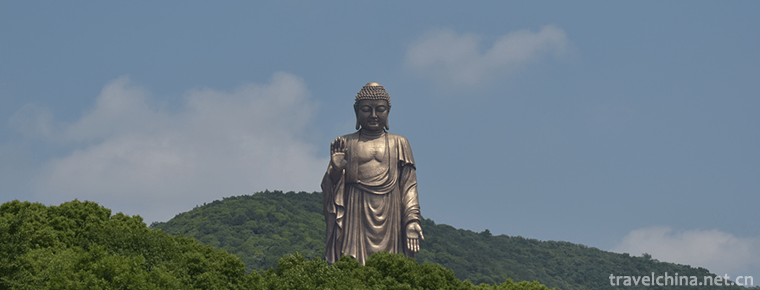
-
Dianchi Lake
Dianchi, also known as Kunming lake, Kunming pool, Yunnan Nan Ze....
Views: 182 Time 2018-10-21 -
Hainan Tropical Wildlife Park and Botanical Garden
Hainan Tropical Wildlife and Botanical Garden is a national AAAA-level tourist attraction with the theme of popular science exposition, conservation and reproduction, sightseeing, leisure and vacation.
Views: 248 Time 2019-01-13 -
Yanzidong in Jianshui County
Jianshui Swallow Cave is located in the Lujiang River Valley, more than 20 kilometers east of Jianshui County, Honghe Hani and Yi Autonomous Prefecture, Yunnan Province..
Views: 107 Time 2019-01-21 -
Qingshui rock
National AAAA tourist attractions, built in the Northern Song Dynasty, were rebuilt in the Ming Dynasty. In the Northern Song Dynasty, the priest Puzu Zen Buddhist monk once practiced here.
Views: 183 Time 2019-02-07 -
Miao Lusheng Production Techniques
Miao Lusheng production process is complex, generally using scraping, cutting, through, hammering, clamping, drilling and other related tools, through the selection of materials, baking materials, mak.
Views: 153 Time 2019-06-05 -
Xingshan Folk Song
On May 20, 2006, Xingshan Folk Song was approved by the State Council to be included in the first batch of national intangible cultural heritage list..
Views: 153 Time 2019-07-08 -
Laojunshan scenic spot in Pingshan County
Laojunshan scenic spot in Pingshan County is a provincial scenic spot approved by the people's Government of Sichuan Province. It is located on the southern edge of Sichuan Basin and is located on the arc-shaped tourism line of Chengdu Emei.
Views: 162 Time 2020-10-16 -
Shicheng mountain
It is located in Shicheng mountain, Hengjiang Town, Xuzhou District, Sichuan Province. The total area is 5500 mu, including 4100 mu of forest. Shicheng mountain inclines from southwest to northeast. It has a good momentum.
Views: 132 Time 2020-10-16 -
Chongzhou jiulonggou scenic spot
Chongzhou jiulonggou scenic spot is located in Sanlang Town, Chongzhou City, with an area of more than 170 square kilometers and 76 kilometers away from Chengdu City. Jiulonggou is known as "Dragon Palace on earth". .
Views: 303 Time 2020-11-05 -
Tibetan lads are really popular
Who is Ding Zhen? He is a Tibetan Boy, 20 years old. On November 25, a tourism propaganda film "Ding Zhen's world" made him popular all over the country. Netizens once thought that his hometown was in Tibet, and the photographer could not help but clarify that Ding Zhen was from Litang County, Ganzi, Sichuan Province..
Views: 95 Time 2020-12-07 -
Schools of Chinese embroidery
Suzhou embroidery has a history of more than 2600 years. It has a considerable scale in the Song Dynasty. In Suzhou, there are xiuyifang, xiuhuanong, gunxiufang and xiuxianxiang. Suzhou embroidery in Ming Dynasty has gradually formed its own unique .
Views: 306 Time 2020-12-12 -
Suining transportation
Suining is a transportation hub city in Sichuan Province, with an equal distance of 128 km between Suining and Chengdu Chongqing. It is an important node city and secondary comprehensive transportation hub between Chengdu and Chongqing. 237km "3-way 7-line" railway.
Views: 123 Time 2020-12-16
